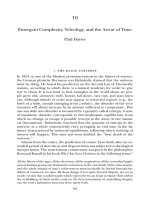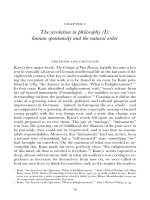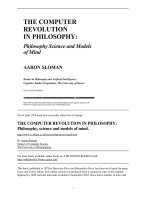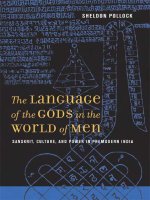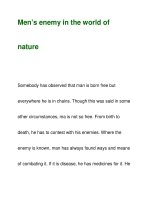The revolution in philosophy (III) - aesthetic taste, teleology, and the world order
Bạn đang xem bản rút gọn của tài liệu. Xem và tải ngay bản đầy đủ của tài liệu tại đây (130.07 KB, 14 trang )
The revolution in philosophy (III):
aesthetic taste, teleology, and the world order
In the picture of the mind’s relation to the world that emerged in Kant’s
first two Critiques and his other works, there was in our general experien-
tial engagement with the world a necessary element of spontaneity on the
part of the mind in apprehending objects of experience; this spontaneity
was both underived and involved neither an apprehension of any given
object nor any self-evident first principle. Instead, its spontaneous char-
acter indicated the way in which it, as it were, sprang up by its powers.
In such spontaneity, the human agent produced the “rules” by which the
“intuitions” of our experience were combined into the meaningful whole
of human experience; without the rules being combined with such expe-
riential, intuitional elements, the results of such spontaneity were devoid
of significance (Bedeutung), in the sense that they were devoid of any objec-
tive relation to the world. When transferred to the moral realm, though,
such spontaneity was no longer chained to intuition for its significance,
and, in relation to action, spontaneity became autonomy, the capacity
to institute the moral law and to move ourselves to action by virtue of
having so instituted it.
There had long been a tradition in philosophical thought that held
that our individual perceptions of things and our deliberations about
what to do required us to have some conception of our own standing
in the overall scheme of things. In particular, the Christian worldview
had demanded that we have an adequate grasp of our own place in the
created order if we were to have any adequate grasp of what was true and
what we ought to do. Although Kant had in one crucial respect seem-
ingly undermined that whole line of thought in his denial that we could
ever have knowledge of things-in-themselves or of the “unconditioned”
totality of nature, in another respect he still subscribed to it, holding that
experiential knowledge and moral knowledge required us to understand
(III): Aesthetic taste, teleology, and the world order
our place in certain totalities. In the case of experience, spontaneity
(combined with intuition) produces not merely individual perceptions of
things, but an experience of a natural order governed by necessary causal
laws and fitting the a priori laws of mathematics and geometry; in the
case of action, it produces a moral order, a “kingdomof ends.” Both of
these conceptions – of a natural order and a moral order – require us to
appeal to Ideas of reason to make them intelligible to us, although such
Ideas could only be regulative, not constitutive of experience. They were
not true representations of things-in-themselves – of the world conceived
as existing wholly apart fromthe conditions under which we could con-
ceive it – but rather necessary ways of ordering the particular elements of
our experience into a meaningful whole. As regulative for the particular
judgments that fell under their respective domains, the theoretical and
practical ideas were, like all normative components of our experience,
instituted by us to serve the ends of reason.
The most obvious difficulty in Kant’s approach was also clearly seen
by Kant himself: how do we explain the way in which we are both
subject to the norms of reason and yet also the agents who institute those
norms? How, after all, can we actually be bound by laws we make?In
particular, Kant’s conception required some account of how “we” insti-
tute norms and whether the norms making up what we call “reason” are
not “instituted” by us at all but simply are what they are. Although Kant
had hardly avoided taking on that issue in his earlier works, he came
face to face with it in his characteristically radical way in The Critique
of Judgment (), his definitive statement of some ideas and themes
he had been working on for some time. In that work, Kant took on
the issue concerning our “institution” of norms by focusing on another
problem: how do we go about orienting ourselves in the moral and
empirical order, and how is such orientation tied into what is neces-
sary for us to make valid judgments? Putting the question in that way
required him to examine what he called “reflective judgments” as dis-
tinct from “determinative judgments.” In “determinative judgments,”
we have a general concept, and we subsume a particular under it.
(For example, we might have the concept of a “rose” and then judge
whether the flower we are observing is indeed a rose – is indeed an
“instance” or “instantiation” of the more general concept.) In the case
of “reflective judgments,” however, we begin with particulars, and we
Part I Kant and the revolution in philosophy
then search for which or what kind of general concepts they might fall
under.
Quite strikingly, Kant singled out both aesthetic and teleological judg-
ments as the prime exemplars of such “reflective judgment.” In the case
of an aesthetic judgment about something judged to beautiful, we en-
counter a beautiful object (for example, a work of art or a beautiful part
of nature), we judge it to be beautiful, and we experience a kind of plea-
sure with regard to our apprehension of its beauty; moreover, in judging
it to be beautiful, we make a judgment that it really is beautiful, not just
“seems to be beautiful” to us, and that commits us to saying that the
judgment is valid for others. Although we might be tempted to assim-
ilate such judgments to empirical judgments, to being simply instances
of the more general type found in ordinary statements such as “it only
looks green in this light, but it really is blue,” such assimilation would
be a mistake. Whereas we can state the general rules (with, of course,
great difficulty) for such empirical judgments (in the case of judging an
object to be blue, those having to do with the conditions that count as
normal lighting and so forth), in the case of aesthetic judgments about
the beautiful, we typically confront individual cases (such as works of
art) for which even in principle no such rule can be found. This might
tempt one to hold that such judgments are therefore merely subjective
responses, mere reports of the fact that it pleased the observer. That,
too, would miss the point, Kant argued, since prima facie there is a differ-
ence between saying that something is pleasant or agreeable (angenehm)
and saying that it is beautiful; the former is a purely private, subjective
judgment, whereas the latter seems to say more than that – it seems to
assert not that the agent finds something pleasant “to him” but that the
object is beautiful and will be experienced by others (who have “taste”)
as beautiful. Indeed, so Kant was to go on to conclude, the pleasure that
we experience in a beautiful object does not precede the judgment that
it is beautiful, but is instead attendant on it.
Since aesthetic experience paradigmatically involves a passive element
of pure experiential receptivity and an active element of (“reflectively”)
judging something to be beautiful, an investigation into aesthetic judg-
ment, Kant concluded, might hold the clue to comprehending the way
in which we are agents subject to norms that we ourselves also institute.
The key to understanding such judgments involves the reflective judg-
ment that what is experienced is beautiful. In such judgments, we are
not applying a general concept (that of the “beautiful”) to a particular
instance, but rather perceiving the instance as beautiful and, as it were,
(III): Aesthetic taste, teleology, and the world order
searching for a concept under which we could subsume it. (We do not, as
it were, walk into a museum armed with a definite and precise concept
of the beautiful and then examine each painting to see if it is subsumed
under that concept.) Thus, judgments about the beautiful are “reflective”
in Kant’s sense; but, as Kant saw, classifying themas reflective only put
off answering the question about why or whether such reflection is nec-
essary for the intuitive apprehension of the beautiful.
The key to answering that question had to do with the fact that judg-
ments about both the agreeable and the beautiful are said to involve taste,
itself the most “subjective” of all the senses. However, to the extent that
we judge something to be indeed beautiful, we are making a judgment
that our subjective state of mind in such experience is, as Kant puts
it, “universally communicable,” something that is of more than merely
private significance and is subject to some universal norms. In making
a subjective judgment about what pleases oneself, however, one is not
making a normative judgment so much as stating some facts about what
one finds pleasant and what one does not. The two senses of “taste”
therefore diverge. In making a subjective judgment about the beautiful,
one is making a normative statement about how oneself and all others
ought to experience something, not an empirical prediction about how
others actually will react to the objects in question; in making a subjective
judgment about what pleases oneself, one is merely reporting on one’s
own private mental states and, on that basis, is entitled to say nothing
about what others ought to feel in experiencing the same thing (although
there might indeed be room for empirical prediction, as when one ad-
vises a friend that something on the menu is not likely to be something
that he will find agreeable).
The experience in question must therefore be crucially different from
the private subjective experience of simply finding something agreeable.
In making a judgment about some private experience of agreeableness,
we do not presume that we can communicate to others who do not
happen to share that kind of mental state (who do not, for example,
find a particular smell “pleasing”) anything about why they also ought to
find that state pleasant to themselves. In judgments about the beautiful,
however, we experience something that we can communicate, although
our judgment is not based itself on concepts, since we cannot prescribe a
rule about such beauty. We cannot, as Kant points out, “compel” people
to believing something is beautiful at least in the same way that we can
“compel” themto accept what follows fromthe evidence in objective
judgments.
Part I Kant and the revolution in philosophy
Such experience of the beautiful as universally communicable must
therefore be structured by universal norms that cannot themselves be
explicated as concepts, since there are no rules for determining what
counts as beautiful. The condition of the possibility of such experience
is thus the possession of some “universal” or “shared” sense – that is, the
capacity for aesthetic taste. Just as possessing a concept does not mean that
one is in some particular subjective mental state but instead possesses an
ability – that one knows how to “exhibit” the concept in experience, one
knows how to make judgments using it in accordance with universally
valid rules for its use and application – the possession of taste means that
one has the ability to apprehend objects as beautiful. Taste is thus an
ability to have such aesthetic appreciation, not an ability to state rules
about what counts as beautiful.
Aesthetic appreciation itself thus cannot be equivalent to a simple
experience of pleasure itself, since that would not be “universally com-
municable.” This, of course, made such an ability very puzzling: since it is
a universally communicable state, it involves norms – since only norma-
tive matters can be so communicated – but it cannot involve conceptual
norms since there are no rules for such judgments. It must therefore in-
volve the cognitive faculties of the mind in a way that does not conform
to rules. Kant concluded that aesthetic appreciation must therefore in-
volve the way in which both imagination and intellect (der Verstand, “the
understanding”) are in free play with each other – free in the sense that
their interaction with each other is not constrained by any rule. When
the result is a harmonious free play between intellect and imagination in
experience, it is an apprehension of something as beautiful.
The experience of the beautiful thus involves the imagination, al-
though in a crucially mediated way. Although the intellect is governed
by the concepts (the rules) necessary for the possibility of experience,
the imagination is free to combine the matters of experience according
to its own plan. When, however, the imagination constructs a unity of
experience that, although not guided by a concept (a rule), is nonethe-
less in harmony with the kinds of conceptual judgments produced by
the intellect (as guided by rules), and this harmony is itself spontaneously
produced without any rule to guide it, then one has the possibility of
an apprehension of the beautiful. Such harmonious free play, however,
is not itself directly experienced (at least in the same way in which a
feeling of agreeableness or pleasure is directly experienced); it is by an
act of attending to it, of reflective judgment, that the agent apprehends the
harmony.
